
"I have used a wide variety of secondaries and Jackson ImmunoResearch has consistently been the best. The fluorophores are bright and stable and their selective (x reactivity removed) secondaries have always shown species specificity in multiple labeling."
Janet Duerr, Ohio UniversityRating: 5.0
Given their unique properties, VHH antibodies (NANOBODIES®) are growing in popularity as immunological tools. Jackson ImmunoResearch has created reagents to facilitate recognition of VHH antibodies in multiple platforms, including Western blotting, ELISA, flow cytometry, and immunofluorescence.
Read more about non-canonical immunoglobulins in camelid species.
The utility of polyclonal secondary antibodies lies in their ability to recognize multiple epitopes on a target (primary) immunoglobulin. VHH domain antibodies are obtained by immunizing goats with alpaca VHH fragments which are highly purified from naïve alpaca serum. We have shown that the antibodies have robust recognition for both alpaca and llama VHH. However, some recombinant VHH may not display many of the antigens present on native VHH fragments, making these difficult to detect with the secondary antibodies.
Two antibody specificities are offered. AffiniPure® Goat Anti-Alpaca IgG, VHH domain (min X Bovine Serum Proteins) (128-005-232) is broadly reactive, and is recommended for screening. For multiple labeling applications, or to minimize background tissue staining, use AffiniPure® Goat Anti-Alpaca IgG, VHH domain (min X Bovine, Human, Mouse, Rabbit and Rat Serum Proteins) (128-005-230). As shown in figure 3, signal strength may vary between the two versions. Fab fragments specific for the VHH domain are also available when imaging needs require smaller detection complexes.
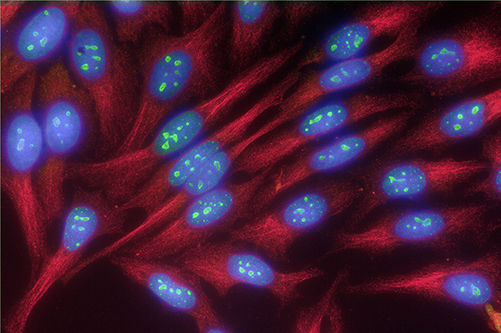
NANOBODIES® are commonly generated from the VHH framework of either llama or alpaca heavy chain-only antibodies. The Western blot (figure 2) shows that Goat Anti-Alpaca VHH detects both alpaca and llama VHH frameworks in their denatured state. The variation in migration reflects differences among VHH antibody structures, notably the VHH dimer L4*.
As demonstrated by ELISA (figure 3), Goat Anti-Alpaca VHH antibodies recognize the native form of both alpaca and llama rVHH. Different rVHH constructs are recognized with varying signal strength, suggesting that some rVHH do not express antigens found on the immunogen (VHH fragments from naïve alpacas). In most cases, 128-035-232 provides stronger signal than 128-035-230 because it is less highly cross-adsorbed against other species. The intended application should be considered when choosing the antibody specificity: if species cross-reactivity is not a concern, use (128-035-232) for greater sensitivity.
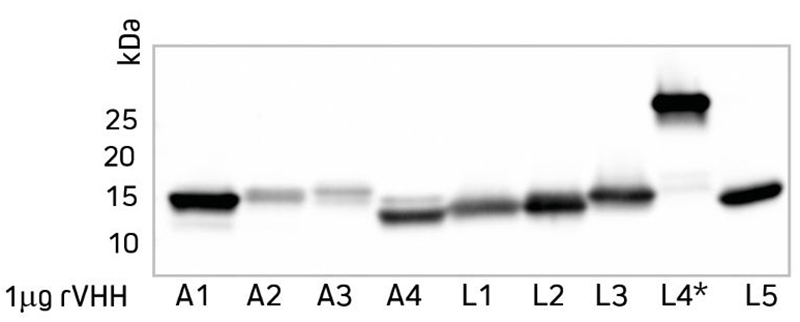
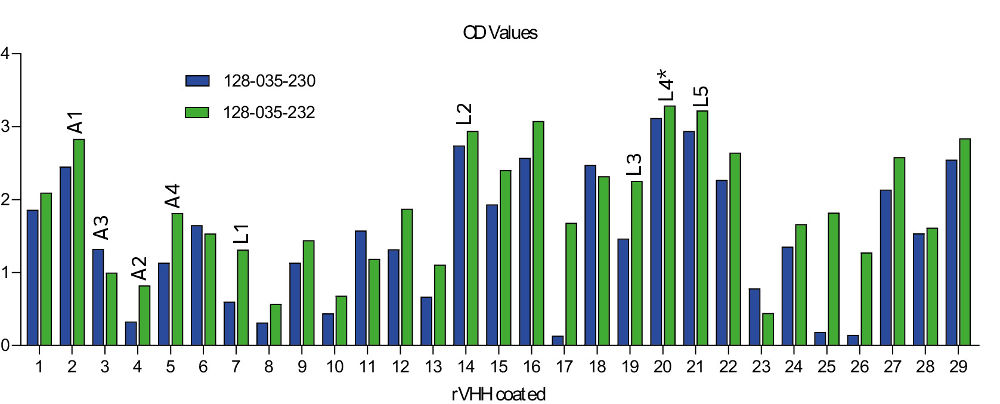
VHH antibodies are growing in popularity as immunological tools. Jackson ImmunoResearch has created reagents to facilitate detection of VHH antibodies in multiple platforms, including Western blotting, ELISA, flow cytometry, and immunofluorescence.
After a VHH antibody has bound its target, detection using a secondary antibody is an alternative to tag-directed detection. The secondary antibody provides signal amplification and the flexibility of increased conjugate options.
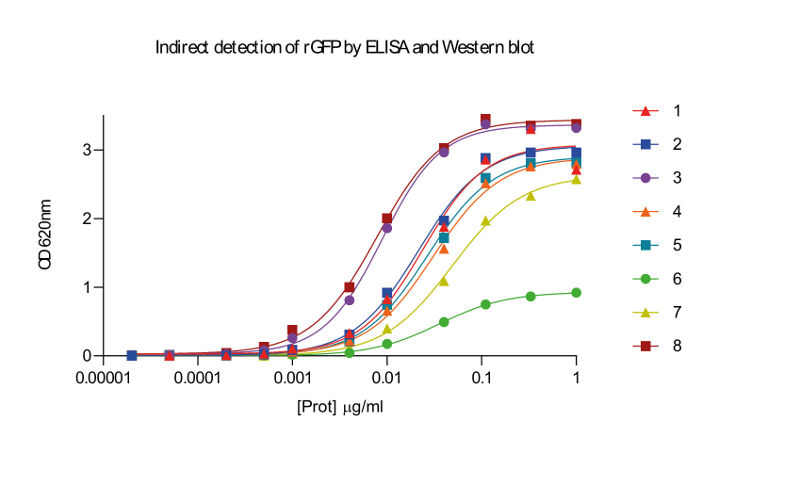
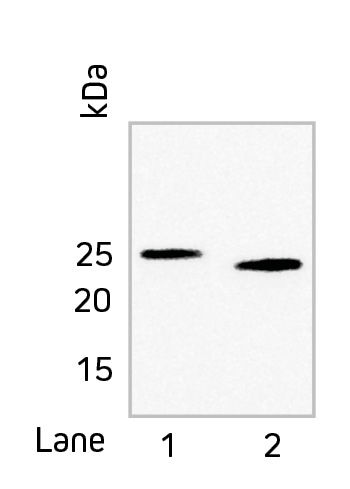
Recombinant VHH constructs can be candidates for therapeutic applications, creating a need to track their presence in animal models or patients. Goat Anti-Alpaca VHH antibodies (e.g. Alexa Fluor® 488 conjugate 128-545-230) can be used to detect VHH on patient cells, without recognizing endogenous IgG or primary antibodies derived from mouse, rabbit or rat. Current oncology research employs NANOBODY®/VHH technology in a number of T cell redirection strategies to use (innate) immune defenses. These include the generation of bispecific formats to recruit and activate cytotoxic or γδ T cells, the design of NANOBODY®-derived chimeric antigen receptor (CAR) T cells, and the development of immune checkpoint blocking NANOBODIES® (Chanier and Chames, 2019). Characterization of the modified T-cells is typically performed by flow cytometry, allowing sorting and expansion of the cells expressing the CAR.
We used polyclonal alpaca VHH anti-human IgG (rather than a CAR) to demonstrate the utility of 128-545-230 in flow cytometry. The panels below represent samples gated on lymphocytes. The Goat Anti-Alpaca VHH does not recognize the mouse anti-CD19, and detects human IgG only if the VHH anti-human IgG is present.
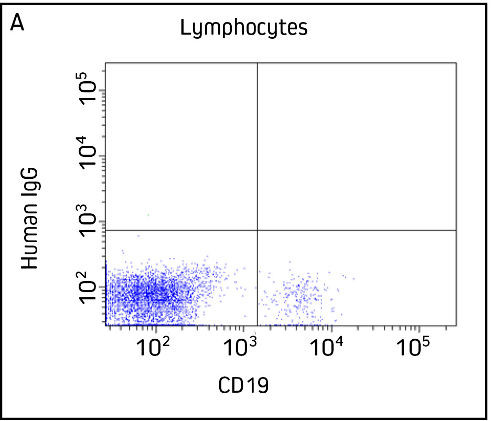
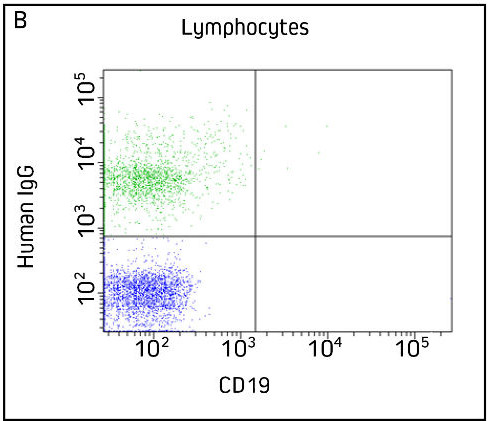
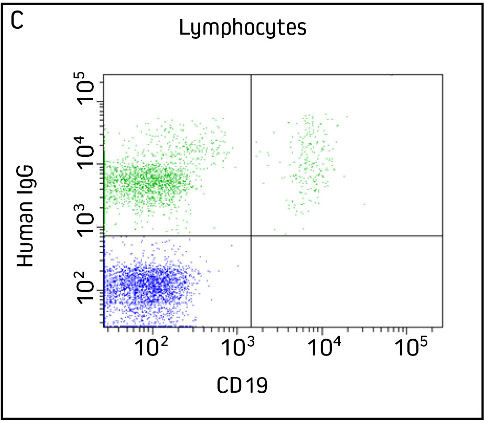
Detection using VHH antibodies requires reporter molecules such as fluorescent probes or enzymes to visualize the protein of interest. Conjugated Goat Anti-Alpaca VHH antibodies afford the inherent benefits of indirect detection such as signal amplification and conjugate choice. Goat Anti-Alpaca VHH (min X Bov, Hu, Ms, Rb, Rat Sr Prot) allows detection of VHH antibodies while minimizing tissue background and mislabeling of primary antibodies from commonly used primary antibody hosts.
For multiple labeling applications, or to minimize background tissue staining, use AffiniPure® Goat Anti-Alpaca IgG, VHH domain (min X Bovine, Human, Mouse, Rabbit and Rat Serum Proteins) (128-005-230).
JIR’s 50kDa conjugated Fab fragment Anti-Alpaca IgG, VHH domain-specific antibodies can be used in combination with a primary VHH antibody to provide a binding complex much smaller than traditional antibody-antibody pairs making them favorable partners for super-resolution microscopy.
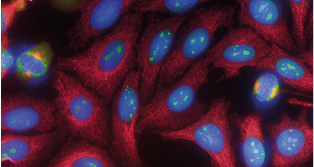
JIR’s Anti-Alpaca antibodies recognize both alpaca and llama IgG VHH domain.